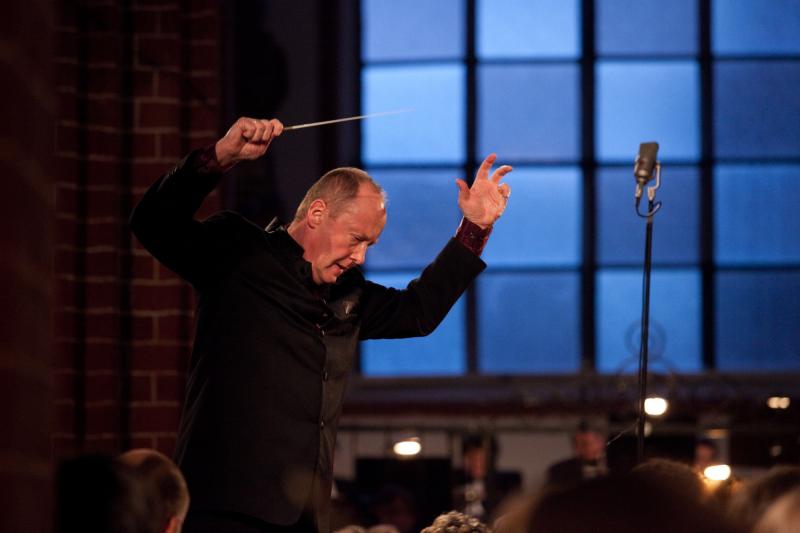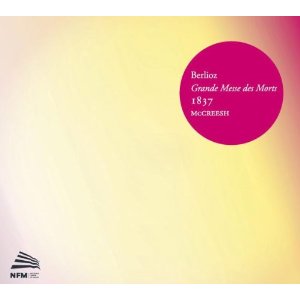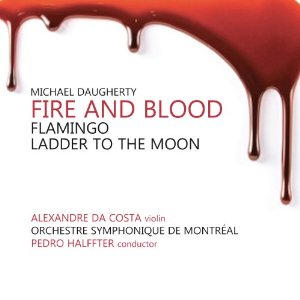Classical CDs Weekly: Berlioz, Daugherty, Purcell | reviews, news & interviews
Classical CDs Weekly: Berlioz, Daugherty, Purcell
Classical CDs Weekly: Berlioz, Daugherty, Purcell
Brash Americana, English Baroque and some very loud French music


After last week’s Mahler 8, another gargantuan choral work makes a welcome appearance on disc. Berlioz’s Grande messe des morts was first performed in the church of Les Invalides in 1837. The composer had been disgusted by the meagre musical resources on offer at St Peter’s in Rome – a colossal space serviced by an 18-voice choir and a weedy portable organ. Hearing a 600-piece childrens’ choir echoing through the expanses of St Paul’s Cathedral in London made a huge impression on the young Berlioz, and the Grande messe makes idiomatic use of extravagant orchestral resources: four offstage brass bands in addition to multiple timpani, a huge array of percussion and an augmented string section. The surprise lies in the restraint with which Berlioz uses these enormous forces, which are only marshalled in full in three of the work’s 10 movements. In the loudest passages there’s a bizarre mismatch between the doomy Latin text and the music’s brassy ebullience.
Paul McCreesh is best known for his performances of Monteverdi and Handel. He travelled to the Polish city of Wrocław to make this recording, his own Gabrieli Consort forces imported along with brass players from Cheetham’s School in Manchester to join with Wrocław players and choirs. And, well recorded in a suitably reverberant acoustic, it sounds stunning. You’re left reeling at Berlioz’s musical imagination, notably the combination of low flutes and trombone pedals in the Hostias. Tenor Robert Murray is a joy, notably when soaring over the muffled cymbals in the closing Agnus Dei. Fans of Berlioz’s more mercurial music might find that the work’s stately unfolding takes time to get used to. Stick with it – this is a definitive recording of a staggering piece. Berlioz’s dramatic sense and canny pacing make this vast work as entertaining as it is moving.
Paul McCreesh on Berlioz's Grande messe

American composer Michael Daugherty has a knack for finding inspiration in unlikely places. He’s written a symphony based on the story of Superman, a Jackie Onassis opera and a bassoon concerto called Dead Elvis. At his best he’s one of the few composers who can meld popular and serious styles effectively without sounding too self-concious. His music is brash, strident and accessible, rarely lapsing into sub-minimalist doodling. You don’t expect solemnity or profundity from Daugherty, but you will have an enjoyable time. Fire and Blood is a 2003 violin concerto premiered in Detroit – Daugherty’s starting point was a vast mural commissioned by Ford from the Mexican artist Diego Rivera. Rivera had been impressed by his 1932 visit to the vast Ford motor plant in the city, commenting on “the wonderful symphony which came from the factories where metals were shaped into tools for men’s service”. Maybe Daugherty suffers from having too many ideas; the structure of the concerto seems to buckle a little. But there are great things here – the mariachi echoes in the sultry second section, inspired by Rivera’s wife Frida Kahlo, and the propulsive depiction of an assembly line in the finale, dominated by metallic percussion and whip cracks. It’s played with the right amount of exhibitionist flash by the Canadian violinist Alexandre de Costa, with the Orchestre Symphonique de Montréal under Pedro Halffter offering secure but uninhibited support.
Flamingo is a display piece for two stereophonically separated tambourines and orchestra. There’s a marvellous bluesy bassoon solo in the central section offering brief respite from Daugherty’s restless energy. We’ve also Ladder to the Moon, an engaging two movement work for chamber ensemble suggested by Georgia O’Keeffe’s astonishing 1920s paintings of skyscrapers. It’s all technically impressive and highly entertaining.

Miracles of precise concision, the sonatas on this disc were published in 1683. The violin writing shows the influence of several Italian virtuosi who had recently arrived in London; there’s a teasing flamboyance and glitter to some of the faster movement. Keyboard player Matthew Hall’s sleeve note quotes from Purcell’s preface to the collection’s first publication. Referring to himself in the third person, he assures the reader that “he is not mistaken in the power of the Italian Notes, or elegancy of their Compositions, which he would recommend to the English Artists”. And lurking unmistakeably beneath the surface of these pieces is a recognisably English sensibility – for all the occasional flash, the music still sounds very much like Purcell. Though described as Sonatas in Three Parts, there’s almost always a fourth voice burbling away; Purcell recognised that keyboard players would adapt the bass viol line, and ended up composing separate continuo parts. Matthew Hall divides himself between harpsichord and organ. The darker, minor-key sonatas suit the soft, woody organ tone perfectly, and it’s as if Purcell’s violin lines are resting on velvet cushions.
Sophie Gent and Matthew Truscott are so well matched as violin soloists, supported by Jonathan Manson’s gorgeous bass viol. Time stands still in several of Purcell’s incredibly concentrated slow movements – it’s with disbelief that you read the track listing and note that some last barely a minute. Which is not to say that this is a disc of gloomy Baroque navel-gazing - the faster movements really dance in these players’ hands. It’s a Linn release, so the recorded sound is predictably seductive.
Buy
Explore topics
Share this article
The future of Arts Journalism
You can stop theartsdesk.com closing!
We urgently need financing to survive. Our fundraising drive has thus far raised £49,000 but we need to reach £100,000 or we will be forced to close. Please contribute here: https://gofund.me/c3f6033d
And if you can forward this information to anyone who might assist, we’d be grateful.

Subscribe to theartsdesk.com
Thank you for continuing to read our work on theartsdesk.com. For unlimited access to every article in its entirety, including our archive of more than 15,000 pieces, we're asking for £5 per month or £40 per year. We feel it's a very good deal, and hope you do too.
To take a subscription now simply click here.
And if you're looking for that extra gift for a friend or family member, why not treat them to a theartsdesk.com gift subscription?
more Classical music
 Kilsby, Parkes, Sinfonia of London, Wilson, Barbican review - string things zing and sing in expert hands
British masterpieces for strings plus other-worldly tenor and horn - and a muscular rarity
Kilsby, Parkes, Sinfonia of London, Wilson, Barbican review - string things zing and sing in expert hands
British masterpieces for strings plus other-worldly tenor and horn - and a muscular rarity
 From Historical to Hip-Hop, Classically Black Music Festival, Kings Place review - a cluster of impressive stars for the future
From quasi-Mozartian elegance to the gritty humour of a kitchen inspection
From Historical to Hip-Hop, Classically Black Music Festival, Kings Place review - a cluster of impressive stars for the future
From quasi-Mozartian elegance to the gritty humour of a kitchen inspection
 Shibe, LSO, Adès, Barbican review - gaudy and glorious new music alongside serene Sibelius
Adès’s passion makes persuasive case for the music he loves, both new and old
Shibe, LSO, Adès, Barbican review - gaudy and glorious new music alongside serene Sibelius
Adès’s passion makes persuasive case for the music he loves, both new and old
 Anja Mittermüller, Richard Fu, Wigmore Hall review - a glorious hall debut
The Austrian mezzo shines - at the age of 22
Anja Mittermüller, Richard Fu, Wigmore Hall review - a glorious hall debut
The Austrian mezzo shines - at the age of 22
 First Person: clarinettist Oliver Pashley on the new horizons of The Hermes Experiment's latest album
Compositions by members of this unusual quartet feature for the first time
First Person: clarinettist Oliver Pashley on the new horizons of The Hermes Experiment's latest album
Compositions by members of this unusual quartet feature for the first time
 Gesualdo Passione, Les Arts Florissants, Amala Dior Company, Barbican review - inspired collaboration excavates the music's humanity
At times it was like watching an anarchic religious procession
Gesualdo Passione, Les Arts Florissants, Amala Dior Company, Barbican review - inspired collaboration excavates the music's humanity
At times it was like watching an anarchic religious procession
 Classical CDs: Camels, concrete and cabaret
An influential American composer's 90th birthday box, plus British piano concertos and a father-and-son duo
Classical CDs: Camels, concrete and cabaret
An influential American composer's 90th birthday box, plus British piano concertos and a father-and-son duo
 Cockerham, Manchester Camerata, Sheen, Martin Harris Centre, Manchester review - re-enacting the dawn of modernism
Two UK premieres added to three miniatures from a seminal event of January 1914
Cockerham, Manchester Camerata, Sheen, Martin Harris Centre, Manchester review - re-enacting the dawn of modernism
Two UK premieres added to three miniatures from a seminal event of January 1914
 Kempf, Brno Philharmonic, Davies, Bridgewater Hall, Manchester review - European tradition meets American jazz
Bouncing Czechs enjoy their Gershwin and Brubeck alongside Janáček and Dvořák
Kempf, Brno Philharmonic, Davies, Bridgewater Hall, Manchester review - European tradition meets American jazz
Bouncing Czechs enjoy their Gershwin and Brubeck alongside Janáček and Dvořák
 Solomon, OAE, Butt, QEH review - daft Biblical whitewashing with great choruses
Even a top soprano and mezzo can’t make this Handel paean wholly convincing
Solomon, OAE, Butt, QEH review - daft Biblical whitewashing with great choruses
Even a top soprano and mezzo can’t make this Handel paean wholly convincing
 Two-Piano Gala, Kings Place review - shining constellations
London Piano Festival curators and illustrious friends entertain and enlighten
Two-Piano Gala, Kings Place review - shining constellations
London Piano Festival curators and illustrious friends entertain and enlighten
 Echo Vocal Ensemble, Latto, Union Chapel review - eclectic choral programme garlanded with dance
Beautiful singing at the heart of an imaginative and stylistically varied concert
Echo Vocal Ensemble, Latto, Union Chapel review - eclectic choral programme garlanded with dance
Beautiful singing at the heart of an imaginative and stylistically varied concert

Add comment